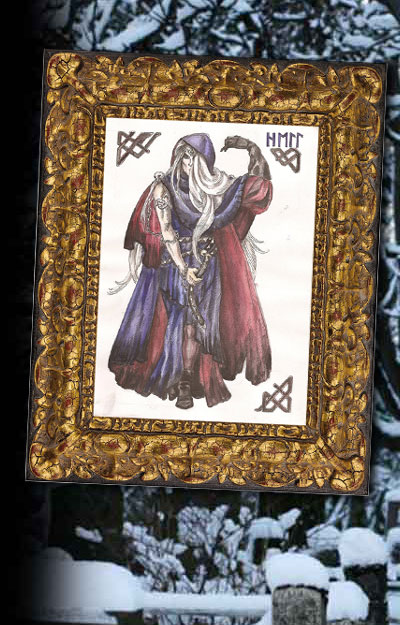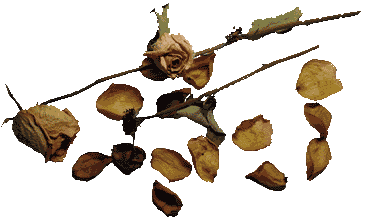Hela's Herbs
by Raven Kaldera
All plants have Gods who love them, and have affinities to them. Some of these affinities are recorded in folklore, and some are not, and must be discovered by experience. Some are from the places where those Gods first touched our world, and some are from new places where their devotees step, and introduce them to new Greenwights.
Hela’s first tree, which is traditionally linked with both her name and that of the Germanic goddess Holda, is the Elder tree (Sambucus nigra). Elders were said to be the guardian of the Hel Road, as Angelica was the guardian to Bifrost, the Rainbow Bridge to Asgard. They were long associated with the Dead and the ancestors, and were also a cornucopia of medicinal remedies – every part of an Elder tree is useful medicinally for something. They were called “the medicine chest of the common people”. Long after the other sacred trees had been discounted, the Elder tree was still treated like a dignified elderly woman, and permission was asked of her before anything was cut or taken. It was considered very bad luck to cut down an Elder tree, and she was referred to as Dame Ellhorn, Dame Ellen, etc.
Hela’s other trees come from the family of Plane trees (Platanaceae spp.) which includes the American Sycamore. The Platanus trees are not native to Europe; they came in around 1500 or so, but Hela has definitely laid her eyes on them since then, especially in America where the Sycamore has become her tree. These trees have especially rigid bark which sloughs off pieces as they grow, so they look mottled and “half-rotted”, although they are quite healthy. In New England where I live, old-timers called them “ghost trees” because of the pale patchy bark of the tall old ones. While you often see them lining roads in Europe and northern America, you don’t see them up next to a house, because their roots (like that of Willow) undermine house foundations. Thus it was considered bad luck to plant one up next to the house. In a list of the magical uses for trees, plane trees and sycamores were listed separately – the author apparently didn’t know how similar they were – and the former was associated with poverty while the latter was associated with the Dead. I thought this was quite appropriate, given that Hela is the Goddess of Poverty who takes any dead souls regardless of rank or wealth, and feeds them all. Ideally, wands or staffs for Hela, or rune-staves for the Ear rune, should be made of plane or sycamore wood, as Elder trees (especially in America) don’t often grow big enough to have more than hollow stems.
The yew-tree (Taxus baccata) is sacred primarily to Ullr as it is used to make bows, but it is also linked with Hela in some folklore, and has been used as a magic wood to raise the Dead. It has its own rune, Eihwaz, the yew-stave.
Wormwood (Artemisia absinthium) is sacred to Hela and her gate-guardian Mordgud. This extremely bitter silvery herb drives out parasites (thus its name), cleans the digestive tract, and is hallucinogenic when distilled into a liquor (absinthe, so bitter that it had to be drunk with large amounts of sugar). It is a liver tonic for short-term use, and is said to help those who are cold and deadened by life’s hard use.
The European poisonous plants – especially the entheogens – are all associated with powerful deities. Thor has Henbane, Tyr has Wolvesbane, and Odin has the Little Red Man, and so forth. Hela’s is Belladonna, the Beautiful Lady, although she also has been linked to the Norns and to the Valkyries. Belladonna has been used for journeying to the Underworld, although this is not recommended unless you have a remarkably good relationship with this capricious and dangerous plant spirit, and you are very, very experienced with such things. The Lady can kill, and it’s good to remember that. She is used in spells to speak to the Dead, usually bound around something.
In this vein, the other Solanaceae vines most similar to Belladonna – the bittersweets – are also her plants. These have both been admired by florists and landscapers for their lovely orange fall berries. At one point, Hela had me make her a wreath of European bittersweet (Solanum dulcamara) with American bittersweet (Celastrus scandens) as a way of saying that Her worship lives on two continents. The very name “bittersweet” reflects her divided body and nature – both grotesque and beautiful at once.
Another one of Hela’s dangerous plants is Hellebore (Helleborus niger), also known as Helle berry and, in post-Christian times, as the Christmas Rose. This plant has been carried for powers of invisibility. She is a plant of madness, and it is said that she will take madness from someone, but her prices are heavy and terrifying.
Ivy isn’t Hela’s per se – it actually belongs to her sister-brother Jormundgand, the Midgard Serpent. However, She loves her sibling, and as Ivy has been grown in many graveyards and is often associated with cemeteries in this country, She has sometimes asked to incorporate it into wreaths with Her other climbing vines. It’s also an easier plant to get hold of than many of the other ones listed here, so if you want to make something of plant matter for Hela, this may be your easiest option.

